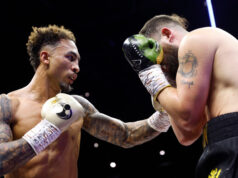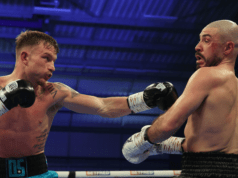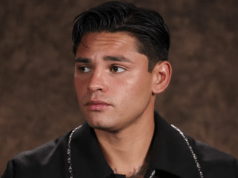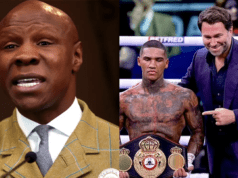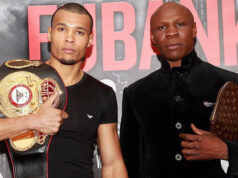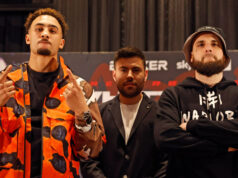Which George Foreman Would Beat the Other in a Fight? Young or Old? 70s vs 90s?
It has often been said when looking back at the incredible career of George Foreman that the older version was better than the younger one. It seems unfathomable that a fighter would be better in his forties than his twenties. At the same time, the 40-something George was vastly different than when he was younger and still managed to win the Heavyweight Title.
Fantasy matchups take place among different fighters, usually from different eras. Let’s do the different era part, but pit a fighter against himself. The only fighter available for such an analysis is George Foreman. His longevity is unmatched and even those who came close never did it all in the same weight class. So how would young George from the 70’s do against the 90’s version?
Strengths and Weaknesses of a Young George Foreman (1970’s)
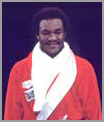
Strengths: His strength was his strength. Watch a young Foreman wreak havoc on the heavybag and you’ll begin to understand the true level of his numbing punching power. If that doesn’t convince you, watch him dribble an undefeated Joe Frazier around the ring en route to a 2nd-round massacre and you’ll believe it then. Guys like Frazier and Ken Norton were competitive with everyone they fought in their primes, with the exception of Foreman—who brushed both aside with ease.
While a frontrunner, Foreman is unfairly characterized by his loss to Ali, which seemed to result from mental resignation as much as the physical beating he took. Against Ron Lyle, young George showed he could emerge from the brink of disaster. It’s only fair to take both fights into account and realize the only time he was ever truly beaten mentally was against the masterful Ali.
Young George was a mean guy. This posed other problems, but in his prime it may have helped him a bit. He always seemed bent on destruction in the ring—fighting with great energy and throwing a lot of punches. He had an edge in the ring, which helped him create the image of an imperturbable wrecking machine. In addition, several fighters may have dropped George, but he had a reliable chin and his face held up fairly well to punishment.
Weaknesses: Young George was not particularly sharp—both in terms of ring IQ and his punches. His punches were the heaviest around, but he had a decidedly unrefined look—winging punches sloppily. His punches thudded but had very little snap. For an Olympic gold medal winner, he was not a very well-schooled fighter. His jab was punishing, but often times not employed enough.
Mentally, he was not a very “together” young man. Seething with anger, he was insecure and not a good guy to be around at times. This radiated in his ring performances, where he had an inability to relax and always believe in himself when the going got rough. Young George expended a lot of nervous energy in the ring, leading to iffy stamina. Against Ali and Jimmy Young, he was unable to make adjustments. Especially against Ali, Foreman stubbornly stuck to the unimaginative game plan of winging shots at Muhammad as a hard as he could, rather than pick his shots more, as he would do later in his career.
Strengths and Weaknesses of an Old George Foreman (1990’s)
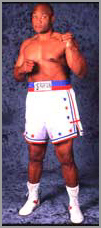
Strengths: When he re-emerged in the late-80’s, he was fatter, balder, and slower, but his head was screwed on right. Even though he was only in his late-30’s, he had the countenance of a wise old man. Suddenly, people wanted to be around him. He was now freed of the petty anger and resentment. Foreman was now a confident man and his self-belief was absolutely genuine.
In the ring, he was utterly relaxed. His body didn’t look very good, but he was no longer bound by vanity. He could care less if his body was suitable for a pose-down, but more concerned about being in good fighting condition. This lack of self-consciousness (in a good way) allowed him to barnstorm the country and begin building up his skills again. For an old heavyweight king who used to ride in limos, going from fight to fight in an old Ford without a floorboard figured to be a bitter pill to swallow. George, however, was unfazed.
In addition to not being worn out by nervous energy, the old version of George added other things to his game that made him more formidable. He always had a ramrod jab, but featured it more during this stage than before. Big George could now control fights with the jab and it seemed to be thrown with greater craft—more pointed and well-placed.
After watching him unravel against Ali and Young, it was surprising to see old George as unshakable a fighter as you’d ever want to see. Fighting a tough era in the 90’s at an advanced age, you never saw old George get rattled. Even when he lost, he resolutely soaked up punishment unflinchingly. He might have been a joker, but there was nothing funny about his toughness during this time.
In keeping with his new image of a wise old man, George developed the ability to think in the ring, even if he was taking a beating. Years later, it’s still hard to not marvel at the presence of mind he exhibited in his knockout of undefeated Heavyweight Champion Michael Moorer. Swelled up and losing badly, he was still trying to walk Moorer into a right hand—convinced he could end it by blinding Moorer with a jab before lowering the boom. Unlike the youthful version, old George could think on his toes with the best of them.
Unlike the mindless battering ram style he employed in the 70’s, the 90’s George placed a higher premium on punch placement. More confident, he reasoned that he could take a man out with one shot. He was more economical, but his punches created a lot of havoc. Watch his fight-ending punch against Moorer. It didn’t look so fearsome, but was powerful enough to not only knock out a Heavyweight Champion and also rip his mouthpiece in two and bust his mouth wide open.
Weaknesses: Never a particularly fast or sharp puncher, old George was almost glacier-like in his return. His lack of speed was jarring at times. This allowed the more quality fighters he fought to pick George apart at times. He wasn’t terribly difficult to hit. When he got hit, his face wouldn’t cooperate all the time. In some of his more demanding fights, he swelled up alarmingly. In fact, it’s a bit surprising in retrospect that he was always allowed to finish fights despite the unsettling amount of swelling he sometimes incurred.
Old George was a different guy. The anger and viciousness had dissipated, giving way to a mellower Foreman. This might have helped him out in an overall sense, but sometimes cost him in the ring. After dropping Alex Stewart early, you could almost see George start to feel for the kid. Whereas a young Foreman would have gunned for the kill, old George let him hang around—a move he would regret, as Stewart later battered George to a large degree before losing a decision.
It became clear later in his comeback that a little movement could give George major problems. It was eyebrow-raising to see boxy slugger types like Tommy Morrison and Axel Shultz actually outbox Foreman. It was almost painful watching Morrison do his best Michael Nunn impersonation, but it was a very effective strategy against old George—who needed a certain level of cooperation from his opponents to succeed.
Old George Foreman vs. Young George Foreman Prediction
When you hear people say that older George would have beaten younger George, it seems they want to exclusively compare Foreman from the Ali fight with Foreman from the Moorer fight. In other words, they want to compare the worst version of young George with the best version of the older George. That only tells part of the story.
Old George might have done better against some heavyweights from history than the younger Foreman. For example, if you put old Foreman in that Zaire ring in 1974, you would have a very different-looking fight. But if you ask the guys he fought in the 90’s who they would rather fight, I strongly suspect they would all prefer to fight old George rather than the 70’s version.
It’s whimsical to say old George would have let young George punch himself out, before lowering the boom late. It’s as if people think 40-something George was capable of playing Ali to his old self. There’s a few problems with this scenario. First and foremost is that old George wouldn’t have been able to absorb that kind of beating. Look what happened to his face when facing the far less lethal fists of Evander Holyfield, Michael Moorer, and Alex Stewart. Now imagine how it would look against one of the more destructive offensive fighters of all time.
Old George benefited from the hesitancy of some of his opponents. Guys with vast advantages in youth, energy, and stamina would be walking on eggshells with George, fearing his power. He would not have received that built-in break from young George, whose lack of wisdom would have actually helped him. He would have just gone out there and let it wing, with no fear of reprisals. The fast pace would have troubled the old man. He might have been able to wear out young George, but would be too battered to do much about it. By the 9th round his face would be in tatters and he’d get the hook.
Result: Young George Foreman wins by 9th-round TKO.


